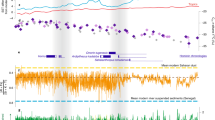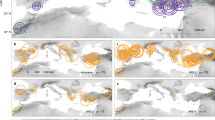Abstract
There is generally a dearth of evidence of the nature of Quaternary climate change within desert systems, which has limited previous interpretations of past environmental change at low latitudes. The Last Glacial Maximum has previously been identified as the peak of Late Quaternary aridity, when desert systems expanded to five times their present extent1,2,3, and low-latitude aridity has been described for previous glaciations4. But little evidence has been derived directly for large desert basins, particularly southern Africa. Here we report new chronological (optical dating) evidence of arid episodes recorded in aeolian sediments from the Mega Kalahari sand sea. Episodic aeolian activity is recorded at the northeastern desert margin, whereas more sustained activity is evident from the southwestern desert core. Several significant arid events are apparent since the last interglacial period, with dune-building (arid) phases at ∼95–115, 41–46, 20–26 and 9–16 kyr before present. Existing atmospheric general circulation model simulations and independent palaeoclimate data indicate that the changes in aridity are related to changes in the northeast–southwest summer rainfall gradient, which are in turn related to sea surface temperatures in the southeastern Atlantic Ocean.
This is a preview of subscription content, access via your institution
Access options
Subscribe to this journal
Receive 51 print issues and online access
$199.00 per year
only $3.90 per issue
Buy this article
- Purchase on Springer Link
- Instant access to full article PDF
Prices may be subject to local taxes which are calculated during checkout


Similar content being viewed by others
References
Sarnthein, M. Sand deserts during glacial maximum and climatic optimum. Nature 272, 396–398 (1978).
Sarnthein, M. & Koopman, B. Late Quaternary deep-sea record on northwest African dust supply and wind circulation. Palaeoecol. Afr. 12, 238–253 (1980).
Street-Perrott, F. A., Marchand, D. S., Roberts, N. & Harrison, S. P. Global Lake Level Variations from 18,000 to 0 Years Ago: A Palaeoclimatic Analysis (Tech. Rep. TR046, US Dept of Energy, Washington DC, (1989)).
de Menocal, P. B., Ruddiman, W. F. & Pokras, E. M. Influences of high- and low-latitude processes on African terrestrial climate: Pleistocene eolian records from equatorial Atlantic ocean drilling program Site 663. Paleoceanography 8, 209–242 (1993).
Thomas, D. S. G. & Shaw, P. A. The Kalahari Environment (Cambridge Univ. Press, (1991)).
Cohen, A. L. & Tyson, P. D. Sea-surface temperature fluctuations during the Holocene off the south coast of Africa: implications for terrestrial climate and rainfall. Holocene 5, 304–312 (1995).
Cockcroft, M. J., Wilkinson, M. J. & Tyson, P. D. The application of a present day climatic model to the late Quaternary in Southern-Africa. Clim. Change 10, 161–181 (1987).
Van Zinderen Bakker, E. M. Comparison of late Quaternary climate change evolutions in the Sahara and the Namib-Kalahari region. Palaeoecol. Afr. 12, 381–394 (1980).
Huntley, D. L., Godfrey-Smith, D. I. & Thewalt, M. L. W. Optical dating of sediment. Nature 313, 257–267 (1985).
Henderson-Sellers, A. & Hansen, A.-M. Climate Change Atlas: Greenhouse Simulations from Model Evaluation for Climate Assessment (Kluwer, Dordrecht, (1995)).
Schneider, S. H. (ed.) Encyclopedia of Climate and Weather (Oxford Univ. Press, New York, (1996)).
Livingstone, I. & Thomas, D. S. G. in The Dynamics and Environmental Context of Aeolian Sedimentary Systems (ed. Pye, K.) 91–103 (Geol. Soc. London, (1993)).
Wiggs, G. F. S., Thomas, D. S. G., Bullard, J. E. & Livingston, I. Dune mobility and vegetation cover in the southwest Kalahari desert. Earth Surf. Proc. Landf. 20, 515–530 (1995).
Thackeray, J. F. & Lee Thorpe, J. A. Isotopic analysis of equid teeth from Wonderwerk Cave, Northern Cape Province, South Africa. Palaeogeogr. Palaeoclimatol. Palaeoecol. 99, 141–150 (1992).
Partridge, T. C. et al. Late Pleistocene and Holocene climatic change in Southern Africa. S. Afr. J. Sci. 86, 302–306 (1990).
Shaw, P. A. & Thomas, D. S. G. The Quaternary palaeoenvironmental history of the Kalahari, Southern Africa. J. Arid Environ. 32, 9–22 (1996).
Brookes, G. A., Cowart, J. B. & Marais, E. Wet and dry periods in the southern African summer rainfall zone during the last 300 kyr from speleothem, tufa and sand dune age data. Z. Fur. Geom.(in the press).
Bloemendal, J. & de Menocal, P. Evidence for a change in the periodicity of tropical climate cycles at 2.4 Myr from whole-core magnetic susceptibility measurements. Nature 342, 897–900 (1989).
Street-Perrott, F. A. & Perrott, R. A. Abrupt climate fluctuations in the tropics: the influence of Atlantic Ocean circulation. Nature 343, 607–612 (1990).
de Menocal, P. & Rind, D. Sensitivity of Asian and African climate to variations in seasonal insolation, glacial ice cover, sea surface temperature, and Asian orography. J. Geophys. Res. 98, 7267–7287 (1993).
Avery, D. M. Late Pleistocene coastal environment of the southern Cape Province of South Africa; micromammals from Klasies River mouth. J. Archaeol. Sci. 14, 405–412 (1987).
Miller, D. F., Yates, R. J., Parkington, J. E. & Vogel, J. C. Radiocarbon-dated evidence relating to a mid-Holocene relative high sea-level on the south-western Cape Coast, South Africa. S. Afr. J. Sci. 89, 35–44 (1993).
Sifeddine, A. et al. La sédimentation organique lacustre en zone tropicale sud au cours des 36000 dernières années (Lac Tritrivakely, Madagascar). C. R. Acad. Sci., Ser. IIa 321, 385–391 (1995).
Kutzbach, J. E., Guetter, P. J., Behling, P. J. & Selin, R. in Global Climates Since the Last Glacial Maximum (eds Wright, H. E. et al.) 24–93 (Univ. Minnesota Press, (1993)).
Imbrie, J. & Duffy, A. SPECMAP Archive (NOAA Palaeoclimatology Program, Natl Geophys. Data Center, Boulder, CO, (1993)).
Little, M. G. et al. Trade wind forcing of upwelling, seasonality, and Heinrich events as response to sub-Milankovitch climate variability. Paleoceanography(in the press).
Aitken, M. J. Thermoluminescence Dating (Academic, London, (1985)).
Stokes, S. Optical dating of selected late Quaternary aeolian sediment from the southwestern United States. Thesis, Oxford Univ. (1994).
Acknowledgements
We thank P. Shaw and G. Haynes for discussions; M. Malifa, M. Moore, B. Adder, P. O'Connor, G. Wiggs, E and K. Walker for technical and field assistance; P. Hayward for drafting assistance; G. A. Brookes, M. Little and D. Kroon for providing access to unpublished data; M. J. Aitken, A.K. Singhvi and C. K. Folland for advice on wider aspects of the research programme; and D. Sexton for help with model data. This work forms part of a wider project on southern African palaeoenvironments funded in part by the Trapnell Fund, the Universities of Oxford and Sheffield; R. Washington was supported by the DOE.
Author information
Authors and Affiliations
Corresponding author
Rights and permissions
About this article
Cite this article
Stokes, S., Thomas, D. & Washington, R. Multiple episodes of aridity in southern Africa since the last interglacial period. Nature 388, 154–158 (1997). https://doi.org/10.1038/40596
Received:
Accepted:
Issue Date:
DOI: https://doi.org/10.1038/40596
This article is cited by
-
Using artificial neural networks to predict future dryland responses to human and climate disturbances
Scientific Reports (2019)
-
Hydrogeology and geochemistry of a tectonically controlled, deep-seated and semi-fossil aquifer in the Zambezi Region (Namibia)
Hydrogeology Journal (2019)
-
Modelled responses of the Kalahari Desert to 21st century climate and land use change
Scientific Reports (2017)
-
Paleolimnological features of a mega-lake phase in the Makgadikgadi Basin (Kalahari, Botswana) during Marine Isotope Stage 5 inferred from diatoms
Journal of Paleolimnology (2017)
-
Crescentic dune migration and stabilization: Implications for interpreting paleo-dune deposits as paleoenvironmental records
Journal of Geographical Sciences (2017)
Comments
By submitting a comment you agree to abide by our Terms and Community Guidelines. If you find something abusive or that does not comply with our terms or guidelines please flag it as inappropriate.



